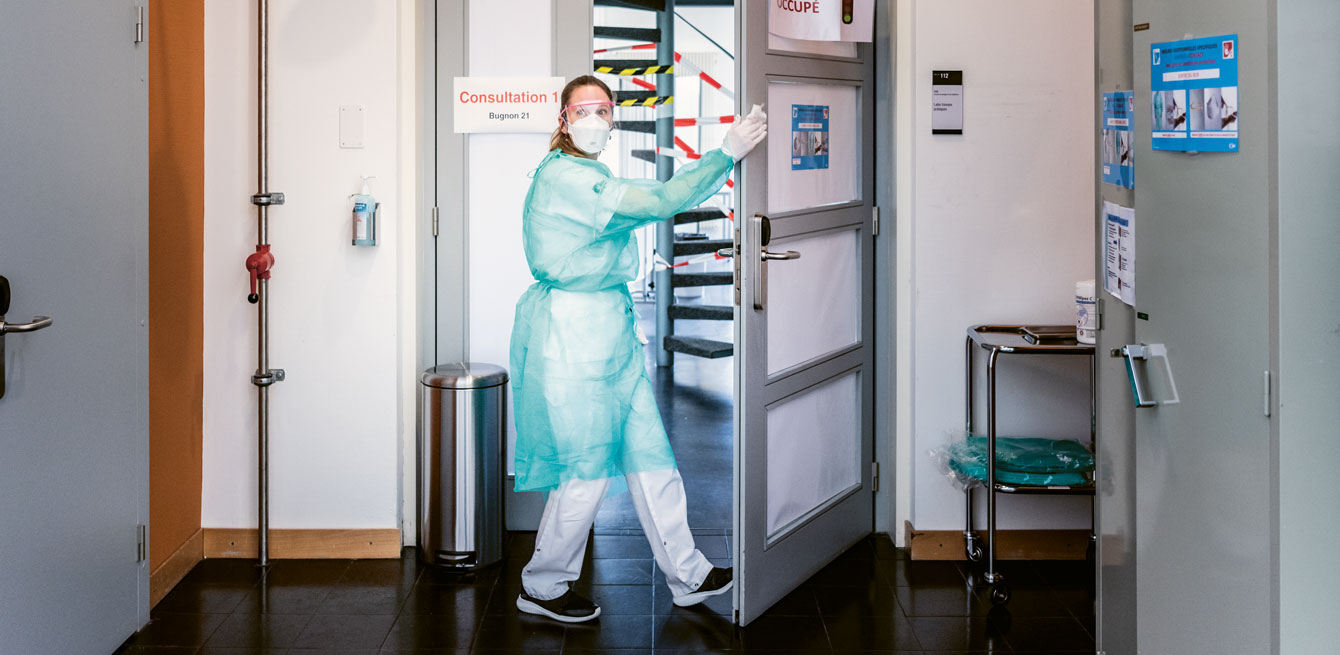
A&E, intensive care, logistics, hospital hygiene, internal medicine... In Vivo recounts the stories of those who have been fighting on the front lines for the past several weeks.
Since 28 February, when the first patient to test positive for COVID-19 was admitted at Lausanne University Hospital (CHUV), the facility has found itself in an unprecedented situation. The gargantuan challenge is one that all the world’s health institutions have had to contend with almost simultaneously. In just a few weeks, more than 30,000 people tested positive in Switzerland, including more than 5,000 in the Canton of Vaud. From the patient’s bedside to the basement of the Logistics department, all 12,000 staff members saw their daily lives turned upside down by the massive influx of patients suffering from a disease we knew nothing about but had to contain with the tools and knowledge available to us at the time.
At the time of writing (Editor’s note: 7 May 2020), the first steps to ease lockdown restrictions have been taken. Although it is still far too early to make an accurate assessment, the glimmer of a return to normal operations gives us the opportunity to start figuring out how hospitals will handle this kind of threat in the future. One thing is for sure. Medicine is no longer considered to have the all-permeating power it once did. The media have relayed messages from medical professionals who have had to grapple with the uncertainty, assumptions and debates of the scientific community, ruling out any possibility of a rapid exit from the crisis with the development of a vaccine miraculously delivered by technology.
What guided the hospital through the turmoil, on top of the self-sacrifice and courage of those who toiled daily at patients’ bedsides, were the values and skills that were already in place before the crisis. That is what has empowered our members of the medical and healthcare staff to fight this battle of humility.
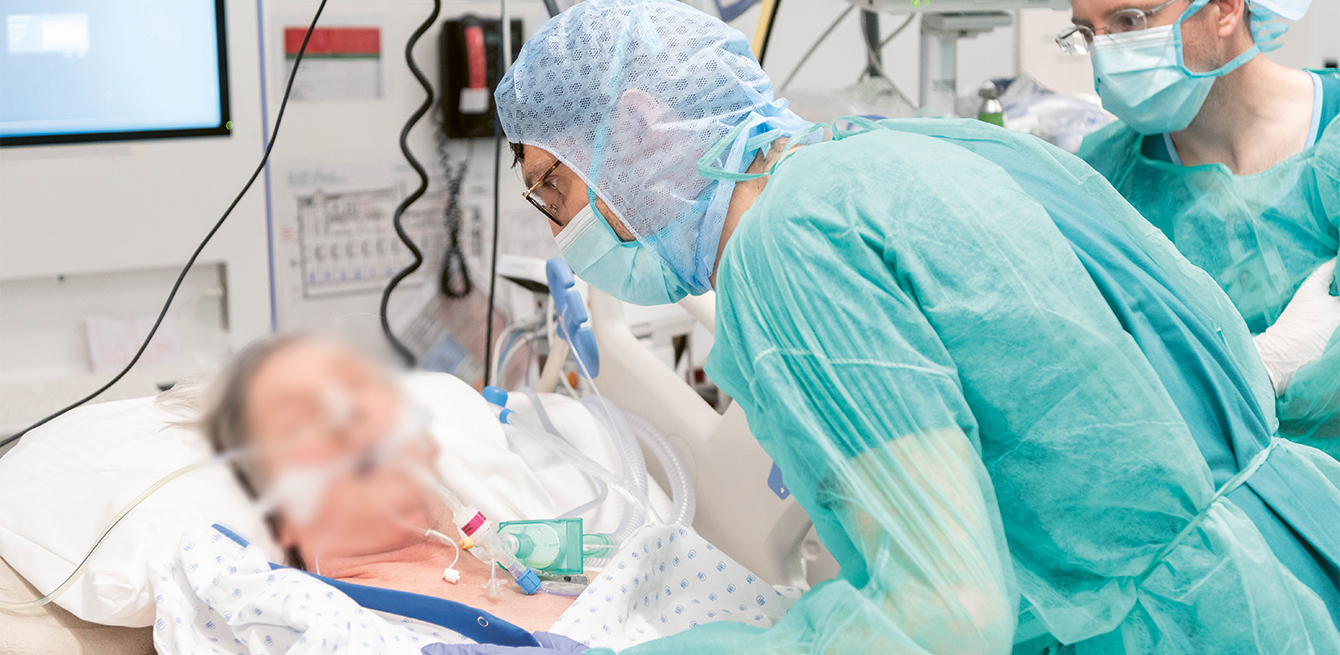
Intensive Care have more than doubled their capacity going from 35 to 80 beds in just a few weeks
In Intensive Care, the challenge of training
When we visited the service (2 March), 38 COVID-19 patients were in care, out of a total capacity of 80 beds at the peak of the pandemic, more than double the usual capacity of 35 beds. Patients are divided between annex A&E facilities, the operating room and the usual beds within the service. “We decided to accept patients gradually at all units at the same time, to prevent us from going over capacity,” explains Mauro Oddo. That was the right strategy to take, but it meant mobilising a large number of hospital staff, which more than doubled. All that interaction ended up being a huge challenge in terms of training and sharing expertise.
Mauro Oddo, the intensive care physician who acted as temporary head of the adult intensive care service during the crisis, believes that it was adherence to standardised bedside practices that saved patients most seriously affected by COVID-19. “If we take just one of the most commonly observed symptoms, acute respiratory distress, patients with the virus were not cared for any differently from the way we’ve been doing it for almost 20 years,” Oddo adds. “Protective mechanical ventilation support (the famous ‘respirators’ that the media were so concerned about at the beginning of a crisis), including the ventral decubitus (the practice of positioning the patient on the stomach to improve the exchange of gases), is a technique that we are familiar with, that has worked and that meets the usual quality standards.”
However, the influx of patients was larger than anything seen before. To cope with it, six additional units had to be created. That required completely restructuring many services to make room for patients. One of the first measures identified in senior management’s plans was to halt non-urgent surgery. An entire floor of operating rooms was emptied, which we turned into intensive care units. The facilities were ideal because they were sterile and had optimal air ventilation. “Working closely with other services, such as anaesthesiology and senior management, we realised that we had the facilities, equipment and human resources. COVID-19 has shown the remarkable solidarity within the hospital. Even though many questions remain, it’s a good sign for the future,” Oddo says.
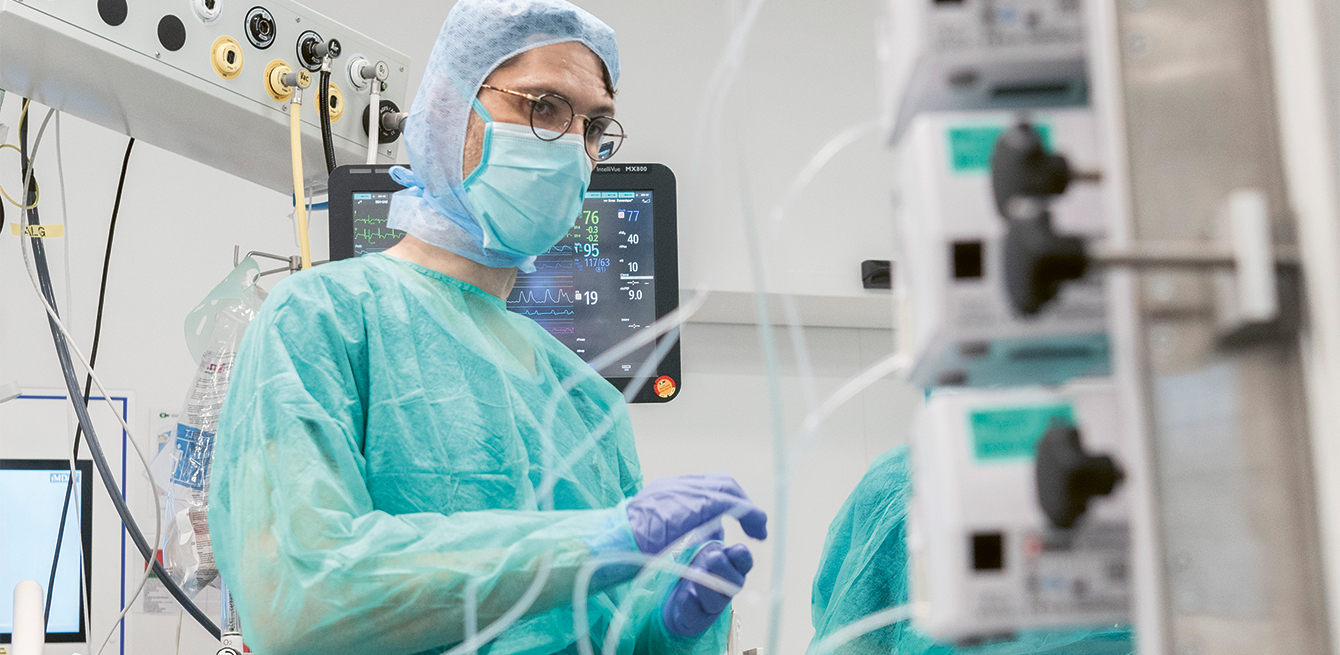
Some operating rooms were transformed into intensive care units
In Internal Medicine, flattening the curve
For one patient with COVID-19 in the Intensive Care Unit, more than ten people were admitted to the Internal Medicine Service.
These figures are daunting, but fortunately far from the most pessimistic predictions. The crisis was mainly managed by chief physician Antoine Garnier in Internal Medicine, a service headed by Professor Peter Vollenweider. He fulfilled his duties while keeping his focus on one objective: to guarantee optimal care while keeping pressure as low as possible.
“To be perfectly honest, the biggest advantage we had, on top of the hard work of all our staff, was the clear and brave decisions made by our senior management, which enabled us to confront this pandemic that could affect both patients and employees.”
Then came an increase in the number of beds and professionals, and a management unit was formed. But the approach to internal communication was another key asset. “Everyone found themselves drowning in a huge mass of information that could be contradictory, between social media, traditional media, what they could hear around them, and so forth. It was crucial for us to establish a way of communicating calmly, and as clearly as possible,” he adds. So to do that, the service set up the “huddle”. Every day at noon on the dot since the beginning of the crisis, a meeting has been held with everyone standing in front of the elevators on the first floor. The point is to report the latest decisions and answer any nagging questions.
Now the huddle is part of our everyday schedule. Perhaps it will remain so after the crisis. But we still don’t know how long the crisis will last. “The lifting of lockdown restrictions presents a whole other challenge,” says Garnier. “Non-COVID-19 patients will be coming back. Even though the number of patients with the virus will gradually decrease, we’re going to end up with an increase in the number of beds occupied by people who must not be in contact with one another. Thanks to the incredible dedication of our staff, the crisis never stopped us from doing our job properly.”

A new daily routine meeting called "huddle" allowed the staff to keep up to date and exchange information
In A&E, the key is foresight
“There, that's our tent!” When entering what is – in normal times – the ambulance garage, Pierre-Nicolas Carron can’t help but smile. No matter what, the transformation is impressive. Where a nondescript covered car park once stood, an expanded space with covered infrastructure now holds 18 beds, a sorting area and all the equipment needed to care for patients, including oxygen and cardiac and respiratory monitoring devices.
Even if it wasn’t used, this facility embodies the direction that the chief of the CHUV’s A&E service had set for himself, always to stay two steps ahead of the spread of the virus and the risk of the hospital being overrun.
“I have always been certain that in the event of a disaster, we could use this space to accommodate patients. Thanks to the work of the hospital’s logistics, construction, engineering, technical and security staff, we were operational in five days!” he says. And don’t imagine it was anything like a war hospital. Between the parquet flooring and air flow control, the facility is quite capable of accommodating patients in the best possible conditions.
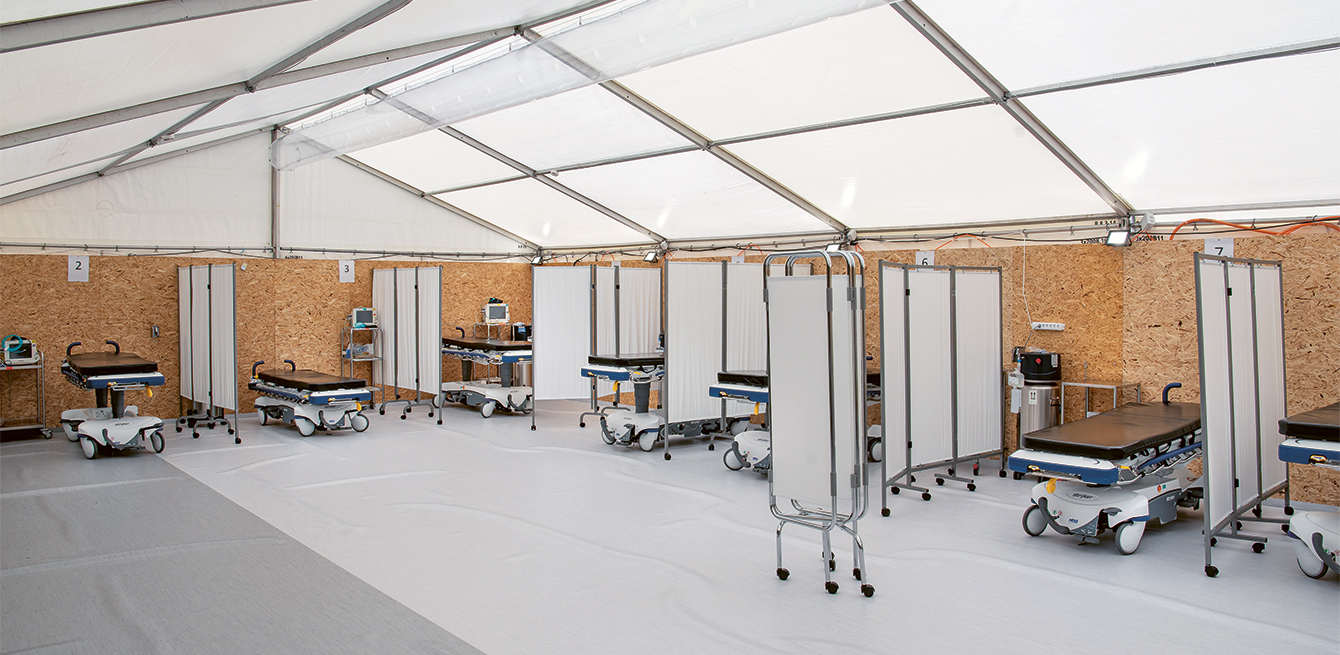
The ER team together with logistics transformed the ambulance garage to welcome patients
Same story at the other A&E unit. The service has doubled its capacity (total of 90 beds), also by requisitioning a corridor planned in case of a sudden influx of patients due to accidents, with adjacent offices.
“Obviously, we had to create new things, rethink patient flows. But what has helped us is our standard procedure for treating patients whose case is not clearly established. That means we have to take all the necessary precautions. And the other important lesson is that our excellent collaboration with the Internal Medicine Department has enabled us to bring down the number of patients in A&E. That is how we were able to cope with peaks of activity and many patients arriving at once. It’s still too early to draw any definite conclusions, but we will clearly take this into account going forward,” Carron says.
In Logistics, reinventing procurement
Relocating, setting up facilities, the risk of equipment shortages – the 1,200 professionals in the CHUV Logistics Department had to overcome enormous challenges. And their chief, Pierre-Yves Müller, took up those challenges with unwavering determination. “There were of course tasks that we were used to, but in proportions never seen before. For example, setting up a service in a new space, or changing the offering and layout of the restaurant facilities to comply with rules of the Swiss Federal Office of Public Health. However, dealing with equipment supply was a whole new world!”
It all started when the hospital realised that the initial stocks of masks and gowns would quickly run out. “Our contract states that we should have had three months of reserves with our suppliers. But we rapidly realised that they would never be able to deliver,” Müller explains. So a broad search was launched to find new procurement sources. “An emissary from the canton came back with a contact from a factory located – ironically – in the Wuhan region. The factory was ready to resume operations in March, but our advance payment enabled them to pay its employees again and get the machine back up and running. This kind of situation is rare in public services, let alone in the healthcare sector!”
Then there was shipping the equipment home.
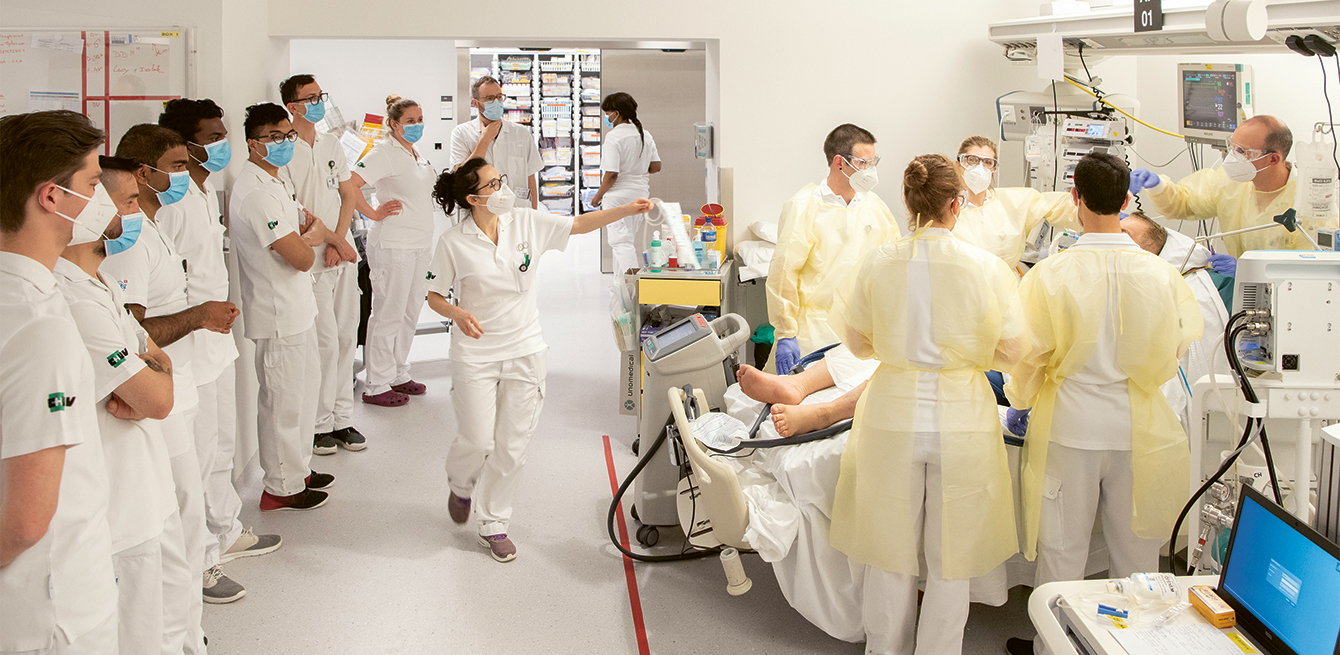
Army came to reinforce the teams, helping with patient manipulations (here on the left)
“Some countries acted as though they were at war. When the Americans ‘steal’ inventory destined for Europe on the airport tarmac, you have to act quickly and make decisions without wasting time,” he recalls. “We were very lucky that the government trusted us. But my first phone calls with the forwarding agents will stay in my mind for a long time – a university hospital trying to book planes directly... We were like aliens to them! But for me, being weird is a positive thing. It just means that we’re the first.”
In Healthcare, solidarity between departments
An explosion in the number of patients means an explosion in the need for professionals. With services completely changing the kind of care provided (discontinuation of all elective surgery and non-urgent consultations, etc.), and staff no longer allowed to take any personal holidays, thousands of healthcare providers had their lives disrupted to an extent never seen before. “We made a list of all the people available and dispatched them based on their expertise and patient needs: intensive care, screening, diagnosis announcements, and so on. The solidarity between the departments was outstanding,” says Nicolas Jayet, medical director with the Healthcare division.
In addition to this backup, more than 130 nursing students finishing their studies at the University of Applied Sciences and Arts came on board. One of their assignments was to help with operations at the screening centre on Rue Bugnon 21, set up specifically for COVID-19 testing on the ground floor of the former historic hospital, which has since become the administrative building. “The number of patients increased tenfold from the very first days, with peaks of more than 250 consultations per day,” recalls Patrick Genoud, deputy director of the Healthcare division. These teams now boast significant expertise in a complex procedure – the swab test – which must be performed carefully to avoid false negative results. “As elective procedures resume, we have also put together mobile teams who work directly at clinical units to carry out tests on hospitalised patients,” he adds. “I believe this is a sign of the trust that the institution can show to these students. The decision of the University of Applied Sciences and Arts Western Switzerland (HES-SO) to reorganise the completion of their final semester before graduating reflects the high recognition for the knowledge they gained during the crisis.”
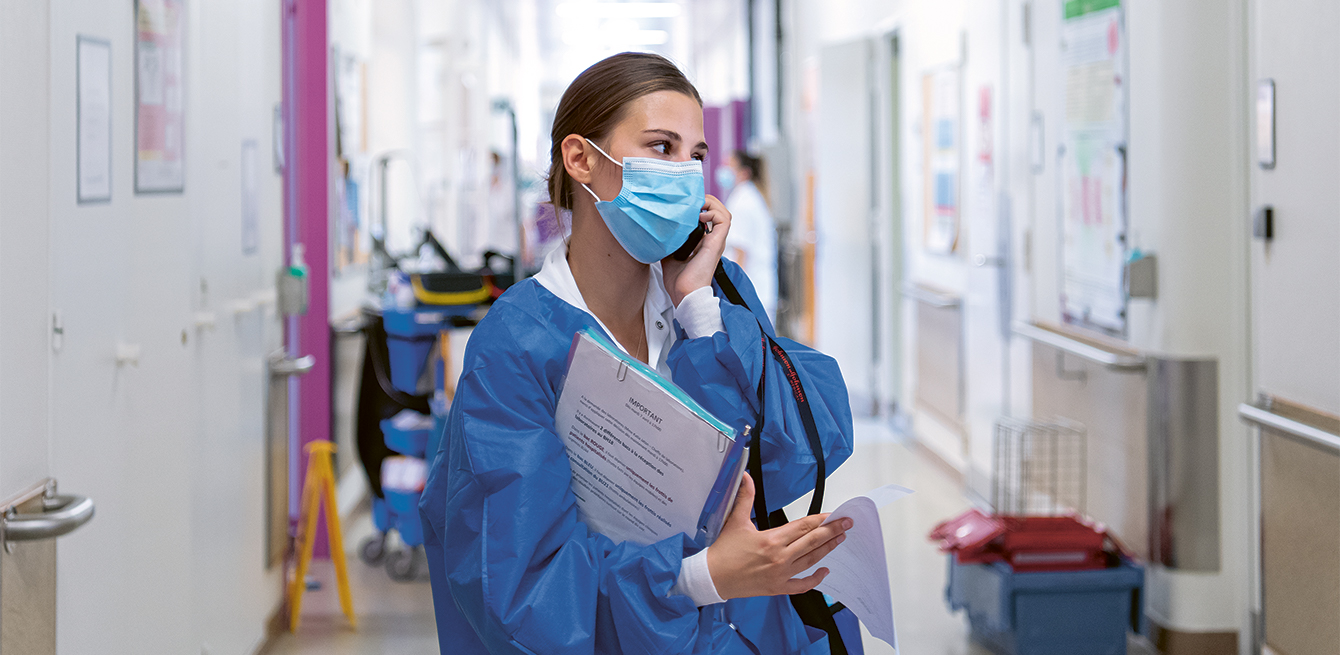
130 HES studients were hired to support the test teams
In Hospital Hygiene, precautions come first
In the office of Laurence Senn, head of the Hygiene, Infection Prevention and Control Unit, sits a large box of plastic visors. “We are currently testing them in dentistry because of the high risk of exposure to splashes,” the infectious disease specialist explains. A note of optimism can be heard in her voice. “This is the first time since the beginning of the crisis that we haven’t had the morning meeting with the officers of the management unit. That’s a good sign.”
Senn identifies the famous “beginning” of it all perfectly: “Everything started picking up on the night of 6 to 7 March, when Pierre-Nicolas Carron and I realised that we were rapidly going run out of beds previously reserved for intensive care patients with COVID-19.” While the A&E chief managed patient flows to guarantee that infected patients did not come into contact with others, Senn made sure the nursing staff was protected. “At first, when looking at images of healthcare professionals in other countries wearing full-body gear – personal protective equipment used especially to fight the Ebola virus – our professionals felt legitimate concern. The choice of personal protective equipment was based on how the virus is transmitted, i.e. exactly like the flu virus, mainly through droplets released in a cough or sneeze and through contact with contaminated surfaces or objects, and more rarely via aerosol-generating procedures performed on the respiratory tract. This choice was discussed within Swissnoso, the National Centre for Infection Control.”
Precautions are of little use if they are not maintained over time
In addition to coordinating things at the national level via the Swissnoso network and monitoring the situation on the ground, the workload quickly sky-rocketed for this small team. “We had to set up a hotline to answer staff questions; we increased the number of informational videos on behaviour to adopt; and we regularly updated the guidelines on how to care for infected patients. We had to be as close as possible to the staff, because their questions were justified and came up as they went along: how to manage the bodies of deceased people, what to do with new types of masks that are not suitable for everyone, etc.” It took a massive collective effort to keep the hospital one step ahead of the spread of the epidemic. “Of course, things would have been even more difficult if we had had to deal with an even larger wave of cases,” Laurence Senn says. “In my opinion, the lockdown was well coordinated, not too early or too late for our local situation. Considering what was happening in northern Italy, the population understood that immediate action was needed.”
The timing is indeed the key, the specialist believes. She knows it all too well: precautions are of little use if they are not maintained over time. “Every week brings its share of new questions. But the last few weeks have taught us something essential. We are capable of changing the face of our hospital and our everyday lives in just a few days. I have no doubt that we will be able to adapt to whatever the future holds, but the most important thing now is to continue applying protective measures. We mustn’t give up!” /
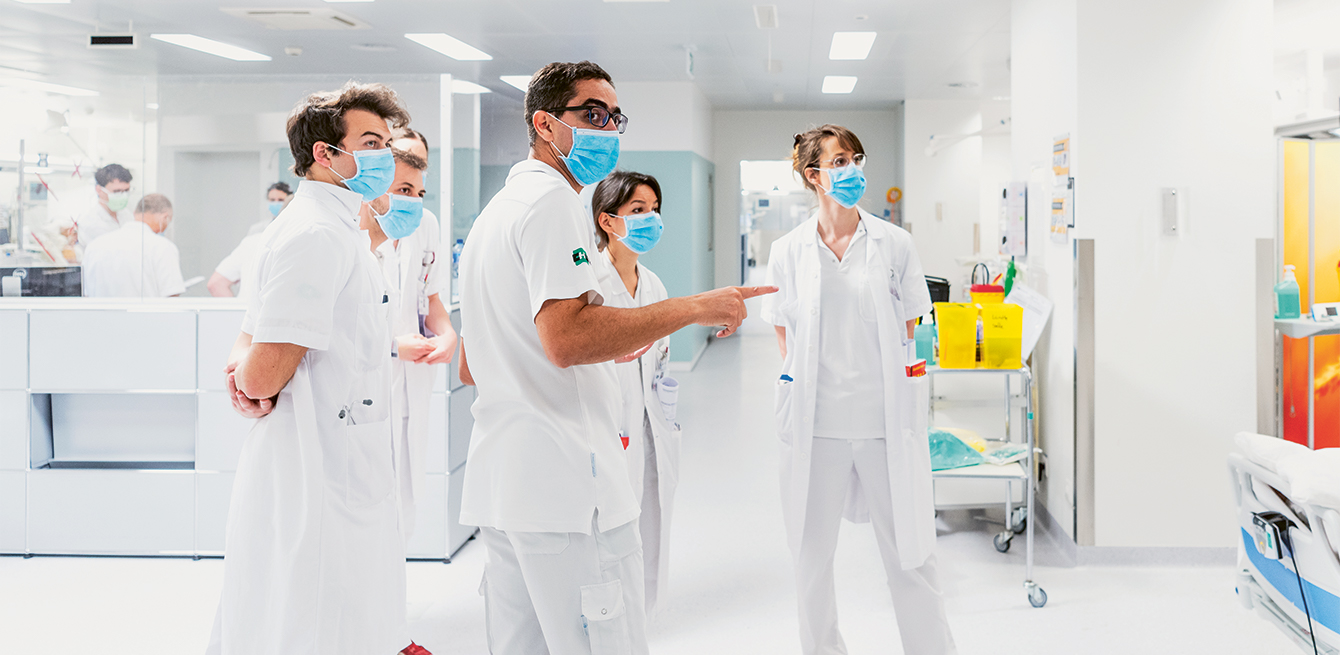
Collaboration between teams was key to absorbing the pics